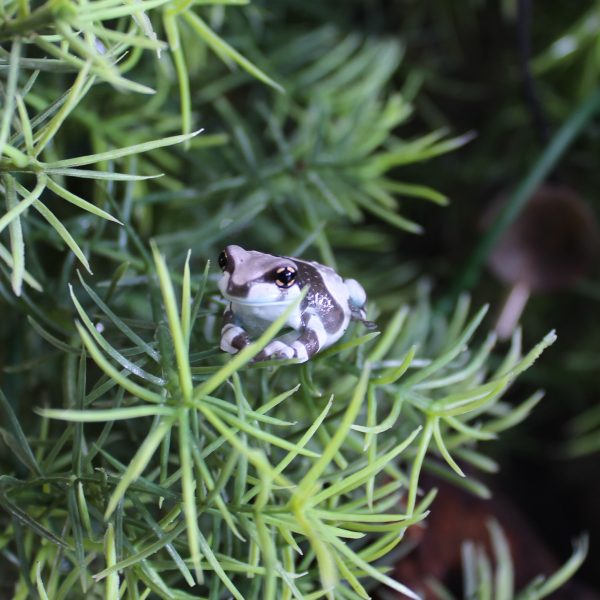Amazon Milk Frog Care
As the name would suggest, this medium sized tree frog is found in the canopy across the whole of the Amazon basin. They live high up in the trees and breed in water filled hollows, never coming down to the ground. They are light grey in colour with brown or black banding, and the babies have more black markings and are often quite strongly blue. They do keep the blue colouration on their feet, and often get white spotting that spreads over the whole body as adults. Their skin is smooth when they are babies, but looks more rough and bumpy as they mature.
They are also known as mission golden eyed treefrogs, because the black markings on their eyes form the shape of a cross.
The vast majority of these frogs that you will see for sale are captive bred; not only do they breed easily in captivity, but a lot of the countries where they are found in the wild have banned the export of wild amphibians. This is no bad thing; captive bred animals tend to make better pets, as they have been around people for their whole lives, and don’t tend to be as secretive.
Females grow to approximately 10cm (4”), but the males are considerably smaller at 6cm (2.5”), so they require a reasonably large enclosure. They are happy to live in groups, so a trio would need a house of 45cm x 45cm x 60cm (18” x 18” x 24”), although of course bigger is always better! Like most amphibians they do like plenty of cover – if they are always close to a hiding place they are more likely to sit out in full view, whereas if they have fewer places to feel safe they won’t risk exposure, and will hide all the time.
They do like a high humidity, but there also needs to be adequate ventilation; the conditions in the Amazon canopy are humid but not stagnant, and the setup needs to mirror this. We prefer to use the screen topped glass terrariums, as they are very well ventilated, and when used with the correct substrate and plenty of cover, they hold humidity well. What is even better is a live planted, bioactive environment – if you’ve ever wanted to give that a go, this an ideal species to begin with!
Although in the wild their ponds are at the bottom of holes in trees, they are quite happy to use a water bowl with low sides to soak in. The bigger the better, although as long as they can get their whole selves into it that will be fine.
Water quality is absolutely vital for amphibians, and whilst it is fine to use tap water it should be dechlorinated first. There are many products available on the market for this, and usually a drop or two will suffice – always read the label! Rainwater can be used, but be careful that the place it is collected from is not too high in contaminants. If it is from a water butt, make sure that it is cleaned regularly – and if possible, try and collect when it has been raining for a while. (The first rain on a dry roof is loaded with road dust, bird poo and other contaminants.)
Mist the enclosure regularly to ensure that the humidity remains high. If time is an issue, there are automatic misting and fogging systems on the market that will do it for you.

Temperature wise, these frogs thrive between 21º C (70º F) and 30º C (81º F), with a 5 to 10 degree drop at night. Most modern centrally heated homes stay quite warm at night so you may not need a separate heater for night time, but do keep an eye on your temperatures (using a digital max/min thermometer) and add in a thermostatically controlled deep heat projector if necessary.
As with all reptiles and amphibians, there needs to be a gradient from warmest to coolest so that your pets can decide for themselves what temperature they want to be at. Always use a good thermometer – our skin is not sensitive enough to tell if the temperature is correct or not!
Like most amphibians, milk frogs will eat pretty much anything that moves that can fit in their mouths. The more different prey items you can supply for them the better; crickets, locusts, waxworms and calci worms are all fine. Ours absolutely love catching soldier flies (the adult form of calci worms) – they’ll do back flips for them! All food items should be gut loaded, and dusted with either a calcium or a calcium and multivitamin/multimineral powder.
Milk frogs are a Fergusson zone 3 species which means they require surprisingly strong UVB lighting. They are often found basking under their UVB throughout the day.
These stout little tree frogs are big enough to tolerate gentle, occasional handling, are relatively easy to care for and are undemanding in their care requirements. They have great personalities, and always appear to have a cheerful expression on their faces! Whether they are your first treefrog or you want to try something a little different, Amazon milk frogs might be for you.

